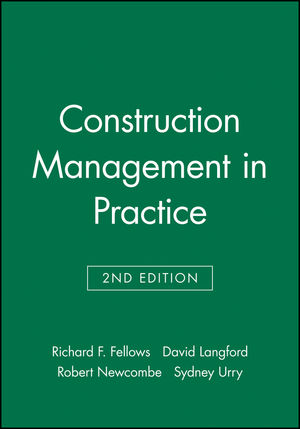Construction Management in Practice, 2nd EditionISBN: 978-0-632-06402-1
Paperback
394 pages
January 2002, Wiley-Blackwell
 This is a Print-on-Demand title. It will be printed specifically to fill your order. Please allow an additional 10-15 days delivery time. The book is not returnable.
|
||||||
Authors' note.
Acknowledgements.
Abbreviations.
1 Construction Management in Practice.
1.1 Characteristics of the construction industry.
1.2 Construction management in practice.
1.3 Strategic management.
1.4 Managing people.
1.5 Managing money.
1.6 Decision-making techniques.
References and bibliography.
2 Introduction to Strategic Management.
2.1 Concepts and definitions.
2.2 The evolution of strategic management.
Summary.
Questions.
References and bibliography.
3 Strategy Systems.
3.1 Strategic planning.
3.2 Strategic vision.
3.3 Strategic learning.
3.4 A hybrid approach.
Summary.
Questions.
References and bibliography.
4 Industrial Relations.
4.1 The history and development of industrial relations.
4.2 The role of employers' associations in construction.
4.3 The structure of employers' associations.
4.4 The role of the trade unions.
4.5 Management responsibilities in industrial relations.
4.6 Empowerment and worker participation.
4.7 The industrial relations machinery.
Summary.
Questions.
References and bibliography.
5 Health and Safety in Construction.
5.1 The magnitude of the problem.
5.2 Health and safety legislation.
5.3 The cost of safety.
5.4 The role of the safety officer.
5.5 Changing attitudes to safety.
Summary.
Questions.
References and bibliography.
6 Managing People.
Part A Planning Human Resources.
6.1 Objectives of human resource planning.
6.2 Procedures for human resource planning.
Part B Managing Human Resources.
6.3 Recruitment to the industry.
6.4 Recruitment to a trade or profession.
6.5 Recruitment to the company.
6.6 Training.
6.7 Investors in People standards.
Summary.
Questions.
References and bibliography.
7 Financing Business Units.
7.1 Types of business unit.
7.2 Sources of capital.
7.3 Capital structures.
Summary.
Questions.
References and bibliography.
8 Budgeting.
8.1 Costs.
8.2 Profit.
8.3 Financial policy.
8.4 Revenues.
8.5 Monitoring and control.
8.6 Clients.
8.7 Consultants.
8.8 Investment appraisal.
Summary.
Questions.
References and bibliography.
9 Financial Performance.
9.1 Value management.
9.2 Decisions.
9.3 Financial reporting.
9.4 Financial management.
Summary.
Questions.
References and bibliography.
10 Quantitative Decision-making.
10.1 Cost models.
10.2 Probability.
10.3 Some statistical ideas.
10.4 Linear regression.
10.5 Stock control.
10.6 Just-in-time.
Summary.
Questions.
References and bibliography.
11 Operational Research.
11.1 Network analysis.
11.2 Linear programming.
11.3 Queueing.
Summary.
Questions.
References and bibliography.
Appendix A Discounted Cash Flow Tables.
Appendix B Properties of the Normal Curve.
Appendix C Use of Current Cost Accounting.
Appendix D Recording Transactions.
Index.



